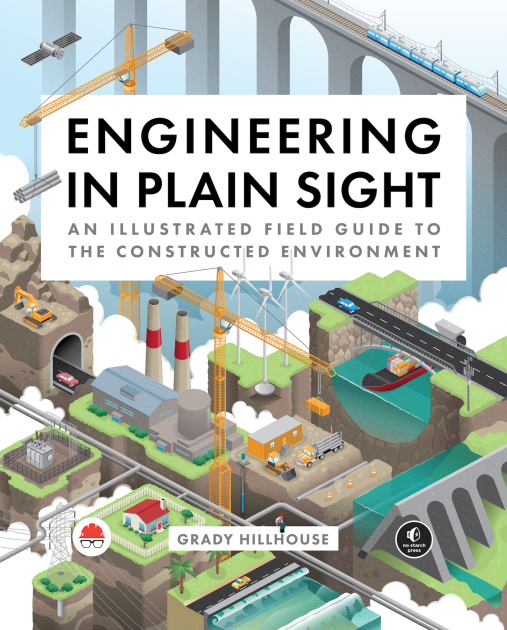 New year, new spotlight—and this one shines on civil engineer and YouTube star Grady Hillhouse. His first book, Engineering in Plain Sight, was released this past Fall to critical acclaim. In the following Q&A, we talk with Grady about how he went from civil engineer to full-time video producer with over 3 million subscribers (hint: woodworking), why all he needed to know about science communication he learned in kindergarten, the importance of average citizens understanding how things work, and the joy of "infrastructure spotting" on the road.
New year, new spotlight—and this one shines on civil engineer and YouTube star Grady Hillhouse. His first book, Engineering in Plain Sight, was released this past Fall to critical acclaim. In the following Q&A, we talk with Grady about how he went from civil engineer to full-time video producer with over 3 million subscribers (hint: woodworking), why all he needed to know about science communication he learned in kindergarten, the importance of average citizens understanding how things work, and the joy of "infrastructure spotting" on the road.
 Grady Hillhouse is a civil engineer and science communicator widely known for his educational video series "Practical Engineering," currently one of the largest engineering channels on YouTube, with millions of views each month. His videos, which focus on infrastructure and the human-made environment, have garnered media attention from around the world and been featured on the Science Channel, Discovery Channel, and in many publications. Before producing videos full- time, Grady worked as an engineering consultant, focusing primarily on dams and hydraulic structures. He holds degrees from Texas State University and Texas A&M University.
Grady Hillhouse is a civil engineer and science communicator widely known for his educational video series "Practical Engineering," currently one of the largest engineering channels on YouTube, with millions of views each month. His videos, which focus on infrastructure and the human-made environment, have garnered media attention from around the world and been featured on the Science Channel, Discovery Channel, and in many publications. Before producing videos full- time, Grady worked as an engineering consultant, focusing primarily on dams and hydraulic structures. He holds degrees from Texas State University and Texas A&M University.
No Starch Press: You got your bachelor’s degree in geography, then later earned a master’s degree in civil engineering, and spent nearly a decade working in the field on infrastructure projects. How did you go from that path to becoming a full-time YouTube sensation?
Grady Hillhouse: Making YouTube videos started as a hobby for me when I was given some woodworking tools. I wanted to learn to use them, and of course, I went to YouTube to watch tutorials. What I found was a community of woodworkers producing videos of their projects and sharing with each other. I was so fascinated that YouTube could be used in a social way (I had only thought of it as a search engine for videos), and I wanted to be a part of the community. Over time, I started including some engineering into my woodworking videos. Eventually I realized that I really enjoy sharing my passion and experience in engineering to others, and I decided to focus on that topic.
I continued making videos about engineering and infrastructure in my free time, and worked to make them better and better. When my first son was born, all that free time I had to make videos vanished. I was forced to make a choice between sticking with my career in engineering or finding a way to support my family with my hobby. Ultimately, I decided I could have a bigger impact on the world producing videos (and writing a book). If everything comes crashing down, I still have my engineering license to fall back on!
NSP: You clearly have a genuine passion for the built environment—it shines through in every one of your YouTube videos and all throughout the new book. So, chicken or the egg: Did this interest spring from your graduate studies and (initial) profession, or did your fervor for infrastructure influence your academic and career pursuits?
GH: I have been interested in how things work since I was a kid, but my passion for infrastructure really didn’t come until college. My undergraduate classes in water resources are really what led me into civil engineering. My engineering classes are where my eyes were opened to all the “hidden in plain sight” details of the built environment. Every class was like turning on a lamp to illuminate some innocuous part of the constructed environment that I had never noticed before, and I just never stopped paying attention since.
NSP: Like Bill Nye and Neil deGrasse Tyson, you’re known as a “science communicator.” But one thing engineers are not typically known for is the ability to explain complex technical processes in laypeople's terms. What’s your trick for translating “engineer speak” into engaging, accessible content without dumbing it down?
GH: My wife was a kindergarten teacher when I first started working as an engineer, and I once got invited to her elementary school to give a presentation about civil engineering. I built a model that shows the different purposes of a dam and reservoir. The first presentation I gave went really well. It seemed like the kids were interested in what I had to say, but I noticed that I was getting questions from teachers. So the next few classes, I started paying attention to the teachers and administrators in the back as I went through my presentation, and was surprised at how attentive they were.
It slowly kind of dawned on me over the course of these five or six presentations I gave that, when I talked about my career to adults, I was usually trying to make myself sound smart and dignified, avoid dumbing it down, or accidentally patronizing someone. But, when I was talking to students, I didn’t have those pretenses.
I’ve basically spent the past 10 years reminding myself that the average adult knows just as much about civil engineering as your average kindergartner. Half of civil engineers just think about dirt and rock all day. We have no good reason to pretend to be so dignified. It’s not just how you keep the interest of a bunch of kindergartners for 15 minutes; it’s how you reach an audience on their level.
NSP: Your book is an “illustrated field guide to the constructed environment” and, indeed, the simple yet incredibly detailed illustrations of every structure being explained on the page really highlight why they should be seen as “monuments to the solutions to hundreds of practical engineering problems,” as you put it. How did these awesome little artistic renderings come about?
GH: The idea for the book was very much rooted in the idea that there are all kinds of structures and devices that we see out in the world but can’t identify, and really, can’t even do an internet search for because they are quite difficult to describe. So, each section focuses on the parts of infrastructure that you can see. Just like using a field guide to birds or plants or rocks, as you slowly start to learn the names and purposes of what you can observe, it makes being outside a lot more fun. It gives you something to pay attention to on walks or road trips.
When I was a kid, one of my favorite things to do while bored was to open an encyclopedia up to a random page and read about what I found. I really wanted readers to use Engineering In Plain Sight the same way where you can just open to any page and find something interesting. I worked really hard with my graphics team at MUTI to make each one of the illustrations as rich and full of detail as possible, and I’m so proud of what we came up with together.
NSP: Similar to your YouTube channel, “Practical Engineering,” has gotten an amazing response from a wide-ranging audience. And I think it’s fair to say that the majority of people who pre-ordered the book or put it on their holiday wish-list were not, in fact, engineers (though it's been popular in engineering circles, too). Why do you think the rest of us are so captivated by getting an inside look at how cell towers, highways, levees—the built world—actually works?
GH: It’s hard to say for sure! But, I suspect part of it is that these structures really are in plain sight. Learning something new about some seemingly mundane part of your immediate surroundings is magical. My favorite comment to get on a video is, “I didn’t even realize I was curious about this until you asked the question.”
NSP: A few months ago, you did a “Practical Engineering” video on a massive—and massively troubled—South Texas bridge project. For those who live in the area, like yourself, it’s a local issue. But your “Harbor Bridge” episode now has over 1.6 million views and nearly 3,000 comments. Do you think that helping people understand the infrastructure in their community (and how it can fail) is a way to strengthen civic engagement through a more informed citizenry?
GH: I really do believe we need to understand our connection to the constructed environment to care for it and to invest in it, which means we need to know at least a little bit about how it works. Our lives rely on many types of infrastructure: roads, bridges, dams, sewers, pipelines, retaining walls, water towers—these structures form the basic pillars of modern society.
And the decisions we make about infrastructure —where to build it, how to pay for it, and when we maintain it—have consequences that affect everyone in powerful and fundamental ways. So, we need everyone to be involved in those decisions, not just engineers and bureaucrats. We all carry some responsibility for how the world is built around us. Investment in infrastructure requires that we value and appreciate it first, and so that’s what I try to do with my videos and the book.
NSP: In addition to opening everyone’s eyes to the feats of infrastructure that surround and support our modern lives, you’ve also introduced us to the oddly joyful pastime of “infrastructure spotting”—something you apparently still get a kick out of. In fact, you note that your “entire life is essentially a treasure hunt for all the interesting little details of the constructed world.” (I bet you’re fun on road trips!) What fuels your ongoing enthusiasm and sense of wonder for the built environment, given you literally wrote the book on the subject?
GH: In any city I visit, I want to learn where they get their water, how their electrical grid is set up, how they manage drainage and flooding and transit and wastewater, et cetera. There is so much variety in how we solve difficult challenges through infrastructure. Plus, we’re always building new things and using new technologies. So, there’s almost always something new to see wherever you go!
 New year, new spotlight—and this one shines on civil engineer and YouTube star Grady Hillhouse. His first book, Engineering in Plain Sight, was released this past Fall to critical acclaim. In the following Q&A, we talk with Grady about how he went from civil engineer to full-time video producer with over 3 million subscribers (hint: woodworking), why all he needed to know about science communication he learned in kindergarten, the importance of average citizens understanding how things work, and the joy of "infrastructure spotting" on the road.
New year, new spotlight—and this one shines on civil engineer and YouTube star Grady Hillhouse. His first book, Engineering in Plain Sight, was released this past Fall to critical acclaim. In the following Q&A, we talk with Grady about how he went from civil engineer to full-time video producer with over 3 million subscribers (hint: woodworking), why all he needed to know about science communication he learned in kindergarten, the importance of average citizens understanding how things work, and the joy of "infrastructure spotting" on the road. Grady Hillhouse is a civil engineer and science communicator widely known for his educational video series "Practical Engineering," currently one of the largest engineering channels on YouTube, with millions of views each month. His videos, which focus on infrastructure and the human-made environment, have garnered media attention from around the world and been featured on the Science Channel, Discovery Channel, and in many publications. Before producing videos full- time, Grady worked as an engineering consultant, focusing primarily on dams and hydraulic structures. He holds degrees from Texas State University and Texas A&M University.
Grady Hillhouse is a civil engineer and science communicator widely known for his educational video series "Practical Engineering," currently one of the largest engineering channels on YouTube, with millions of views each month. His videos, which focus on infrastructure and the human-made environment, have garnered media attention from around the world and been featured on the Science Channel, Discovery Channel, and in many publications. Before producing videos full- time, Grady worked as an engineering consultant, focusing primarily on dams and hydraulic structures. He holds degrees from Texas State University and Texas A&M University.

